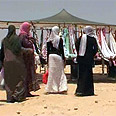
Bedouins of the Negev
צילום: שי רוזנצוויג
Bedouin women in Israel are still being circumcised
‘Khitan’, female genital mutilation, still highly prominent amongst Bedouin communities in Negev; but authorities at loss for how to combat tribal secrecy practice is shrouded in
In June of 2008, Dr. Alex Rabinowitz took one look at a 16-year-old Bedouin female on a Soroka University Medical Center hospital bed and knew what was wrong. The young woman arrived at the emergency room in critical condition, unconscious and suffering from genital hemorrhaging.
A more in-depth examination proved Rabinowitz’s theory true, the girl had undergone the customary Bedouin ritual of “Khitan,” or female circumcision. The procedure, which is carried out on many Bedouin girls her age, was apparently conducted by an inexperience woman from her tribe.
The girl’s father said he was not aware that removing the clitoris would cause medical damage. Immediately after she regained consciousness, the girl's father checked her out of the Beersheba hospital.
Throughout the investigation of the case, the father claimed he did not know who had carried out the procedure and his daughter said she had fully consented.
The age-old practice is shrouded in social silence by the Bedouin communities in the Negev, and few are willing to raise the issue for public debate.
While the accounted number of female circumcisions amongst the Bedouins has decreased over the last few decades, this ceremony is prevalent in some of the group’s settlements in the Negev.
Approximately 200,000 Bedouins live in the Negev, half of them live in the city of Rahat and the permanent towns of Kuseife, Arara, Segev Shalom, Tel Sheva, Hura and Lakiya.
The rest of the population lives in unrecognized villages. Community officials said that the phenomenon is more prominent in the small villages and less in the permanent settlements such as Rahat and Tel Sheva.
Due to the silence surrounding this issue, it is very hard to estimate the amount of female genital mutilation. However, what is known is that the practice seems to be isolated mostly to the Negev region and is hardly seen amongst Bedouins living in northern Israel.
The ceremony reportedly takes place at a time of day when the male members of the tribe are away. A number of women arrive at the young woman’s house and one of the women covers her mouth, while two others hold her down to ensure she cannot lash out.
'90% of Negev's Bedouin women circumcised'
The woman regarded as having the most experience washes the genital area with soap and water, and in recent years with hospital-grade materials. She then cuts the area with a special, small knife. In the past, razors were used. Afterwards, she absorbs the blood. In some cases the girls faint and they usually scream, as no pain medication appears to be involved.The Khitan includes the removal of the clitoris and in some instances, additional parts of the female genitalia.
Health clinics in Bedouin settlements are also well-aware of the circumcision phenomenon but are virtually powerless to stop it. “About 90% of the area’s Bedouin women are circumcised but we are afraid to do anything about it,” said a fearful nurse at a Clalit Health Services clinic.
When the nurse’s supervisors heard that she had disclosed this information, she was immediately asked to leave her job.
However despite the prevalence of circumcision, there are some Bedouins who do not approve of the process.
One Negev resident said, “In the past, men only wanted to marry women who had undergone a ‘Khitan’.
“We would have never even have thought about marrying a women who hadn't done this. Today, it is the opposite. I will not marry a woman who has undergone a ‘Khitan’.”










